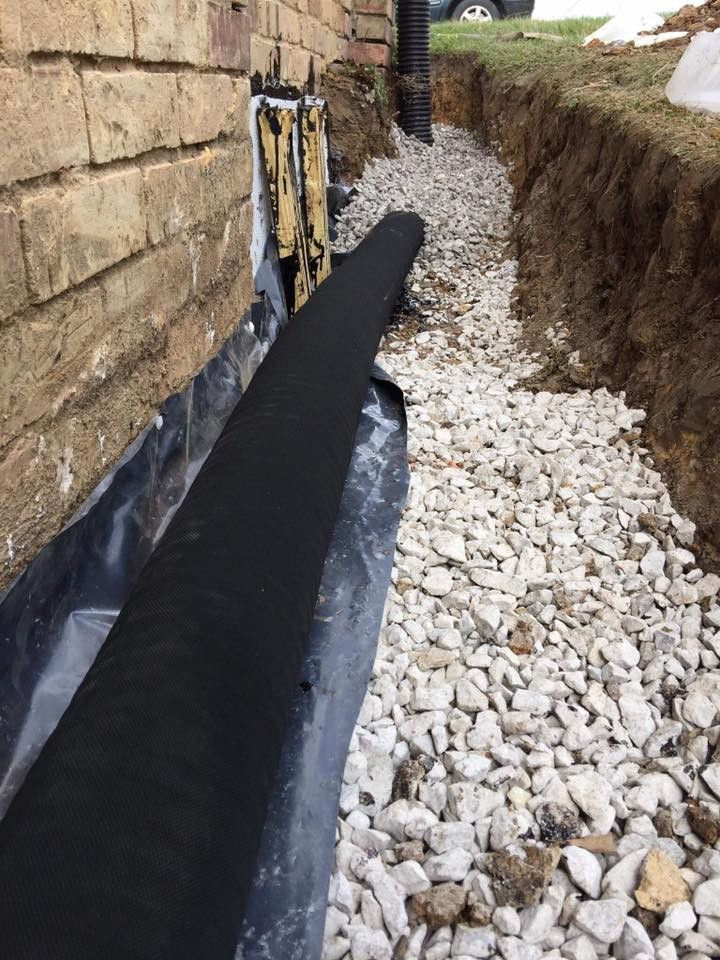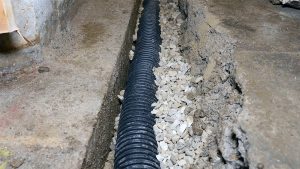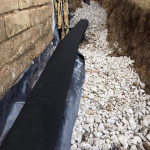In the realm of home maintenance, one crucial aspect often overlooked is the drain system. An efficient drain system is vital for safeguarding your property from water damage, ensuring proper water flow, and maintaining overall structural integrity. In this comprehensive guide to French drains, we will delve into the importance of drain systems, their components, and essential maintenance practices.
Understanding the Significance of Drain Systems
The Role of Drain Systems in Property Protection
A. Importance of Proper Water Drainage
Proper water drainage is not just a convenience; it is a fundamental aspect of property protection. Drain systems play a pivotal role in managing rainwater, preventing excess water accumulation, and safeguarding your home from potential damage. Efficient drainage ensures that water is directed away from critical structural components, such as foundations and basements, reducing the risk of erosion and foundation instability.
B. Consequences of Poor Drainage
The consequences of poor drainage can be severe and far-reaching. Water accumulation around your property can lead to soil erosion, compromising the stability of your foundation. Additionally, stagnant water becomes a breeding ground for pests like mosquitoes and can cause damage to landscaping elements. Inadequate drainage may also result in water seepage into basements, leading to dampness, mold growth, and potential structural damage.
Types of Drain Systems
A. Surface Drains
Surface drains are designed to collect and redirect water that accumulates on the ground surface. These drains often utilize catch basins and grates to capture rainwater and channel it away from vulnerable areas. They are particularly effective in preventing surface water from pooling around patios, driveways, and other hardscape elements.
B. Subsurface Drains
Subsurface drains, also known as French drains, are installed beneath the ground surface to manage groundwater. These systems involve the placement of perforated pipes surrounded by gravel, allowing water to enter the pipe and be directed away from the property line. Subsurface drains are crucial for mitigating water table issues and preventing water from infiltrating basements.
C. French Drains
French drains, a subset of subsurface drains, are trenches filled with gravel or rock containing a perforated pipe or trench. These drains are particularly effective in preventing water accumulation in low-lying areas or regions with high groundwater levels. They provide a reliable solution for redirecting excess water away from foundations and basements, reducing the risk of water-related damage.
Understanding these types of drain systems is essential for homeowners looking to address specific drainage challenges on their properties. Whether dealing with surface water runoff or subsurface sewage and groundwater issues, choosing the right drain system is the first step in ensuring effective water management and property protection.
Components of an Effective Drain System
Gutters and Downspouts
A. Importance of Properly Functioning Gutters
Gutters are the unsung heroes of a robust drainage system. They are designed to collect rainwater running off the roof and channel it away from the foundation. Properly functioning gutters prevent water from dripping or cascading off the roof, reducing the risk of erosion and foundation damage. Regular maintenance, such as cleaning gutters of debris, ensures seamless water flow and prevents clogs that could compromise their effectiveness.
B. Common Gutter Issues and Solutions
Despite their crucial role, gutters are susceptible to various issues. From clogs caused by leaves and debris to sagging due to heavy rainfall or snow accumulation, understanding common gutter problems is key to maintaining an effective drainage system. Solutions include installing gutter guards to prevent debris buildup, ensuring proper pitch for water flow, and promptly repairing any leaks or damage.
Grates and Covers
A. Preventing Debris Blockage
Grates and covers are essential components, especially for surface drains. They act as barriers, preventing debris, leaves, and other pollutants from entering the drainage system. Regular inspection and cleaning of grates and covers are necessary to ensure unobstructed water flow. Choosing the right type of grate or cover for specific French drain system applications is crucial for preventing blockages and maintaining optimal functionality.
B. Choosing the Right Grates and Covers
Selecting appropriate grates, piping, and covers involves considering factors such as material, design, and load-bearing capacity. Depending on the location and purpose of the drain, options range from plastic grates for pedestrian areas to heavy-duty metal covers for vehicular traffic zones. The correct choice not only enhances the aesthetics of the drainage system but also ensures long-term reliability and efficiency.
Drainage Pipes
A. Materials for Drainage Pipes
The selection of materials for drainage pipes significantly influences the durability and effectiveness of the entire drain pipe system. Common materials include PVC, corrugated plastic, and metal. Each material has its advantages and is suited to different applications. Understanding the properties of these materials and their compatibility with specific drainage needs is crucial in designing a reliable and long-lasting drainage pipe system.
B. Proper Installation Techniques
Even the best materials can underperform without proper installation. Ensuring correct slope, alignment, and connections is integral to the success of drainage pipe systems. Attention to detail during installation prevents issues such as water pooling, leaks, and pipe damage. Additionally, the use of geotextile fabric can aid in preventing soil infiltration and maintaining the integrity of the drainage pipes over time.
Understanding these components and their nuances is vital for homeowners and property managers aiming to establish, install, and maintain an effective drain system. From the rooftop to the ground, each element plays a crucial role in preventing water-related issues and preserving the integrity of the property.
Installation and Maintenance Tips
Professional Installation vs. DIY
A. Benefits of Professional Installation
While the allure of DIY projects is undeniable, there are distinct advantages to entrusting the installation of your drain system to professionals. Professional drain line installers bring a wealth of expertise, ensuring that the system is strategically designed to address the unique drainage challenges of your property. They have access to specialized tools and equipment, ensuring precise installation and minimizing the risk of errors that could compromise the system’s effectiveness.
B. DIY Installation Tips for the Enthusiastic Homeowner
For those inclined towards a hands-on approach, certain aspects of drain system installation can be tackled as DIY projects. Simple tasks, such as cleaning gutters, and trench drains, installing downspout extensions, or placing splash blocks, can contribute significantly to maintaining an effective drainage system. However, DIY enthusiasts must educate themselves on proper techniques, adhere to local building codes, and seek guidance from professionals when dealing with more complex components or issues.
Routine Maintenance Practices
A. Cleaning Gutters and Downspouts
Regular gutter and downspout maintenance is paramount to the longevity and efficiency of your drain system. Remove leaves, twigs, and debris from gutters, ensuring unobstructed water flow. Downspouts should be checked for clogs and clogged drains cleared as needed. This simple yet crucial task prevents water backups, ice dams, and potential damage to the roof and foundation.
B. Inspecting and Clearing Drainage Pipes
Inspecting drainage pipes is an often overlooked but critical aspect of maintenance. Regularly check for signs of blockages, such as slow drainage or pooling water. If issues arise, use plumbing snakes or high-pressure water jets to clear obstructions. Additionally, inspect pipe joints for leaks and promptly address any damage to prevent soil erosion and potential structural problems.
C. Addressing Common Drain System Issues
Understanding common drain system issues allows homeowners to address problems proactively. Issues such as standing water, unpleasant odors, or unusual sounds may indicate a malfunction. Identify and rectify issues promptly to prevent more extensive damage. Regular visual inspections and staying attuned to changes in your drainage system can help catch and address potential problems before they escalate.
By striking a balance between professional expertise and informed DIY efforts, homeowners can ensure the proper installation and ongoing maintenance of their drain systems. Regular attention to these aspects of sewer, not only enhances the system’s efficiency but also protects the property from water-related damage, contributing to its long-term structural integrity and aesthetic appeal.
Innovative Solutions for Drainage Challenges
Smart Drainage Systems
A. Integration with Home Automation
In an era where technology is revolutionizing every aspect of our lives, drainage systems are not left behind. Smart drainage systems leverage the power of home automation to provide real-time monitoring and control. These systems can be integrated with weather forecasting tools to anticipate heavy rain events. When inclement weather is predicted, smart systems can automatically adjust water flow, redirecting it away from vulnerable areas to prevent flooding. The ability to control drainage remotely through smartphone apps or voice-activated assistants adds a level of convenience and efficiency previously unimaginable.
B. Benefits of Smart Drainage Systems
The benefits of adopting smart drainage systems extend beyond convenience. These systems can optimize water usage by adjusting flow rates based on real-time weather conditions. Additionally, they contribute to water conservation efforts by preventing unnecessary runoff. The ability to receive instant alerts about potential drainage issues allows homeowners to take swift action, minimizing the risk of property damage. As technology continues to advance, smart drainage systems represent a forward-thinking solution for homeowners seeking efficient and proactive water management.
Sustainable Drainage Practices
A. Rain Gardens
Rain gardens are an aesthetically pleasing and environmentally friendly solution to drainage challenges. These carefully designed gardens capture and absorb rainwater runoff, preventing it from entering storm drains or causing erosion. By selecting native plants with deep roots, rain gardens enhance water absorption and filtration, promoting soil health. Homeowners can strategically place rain gardens in areas prone to water accumulation, turning a potential problem into a visually appealing and eco-friendly landscaping feature.
B. Permeable Paving
Traditional impermeable surfaces, such as concrete and asphalt, contribute to water runoff and can lead to drainage issues. Permeable paving materials, on the other hand, allow water to pass through, reducing surface runoff and promoting groundwater recharge. These materials come in various forms, including permeable pavers and permeable concrete. Installing permeable paving not only aids in effective water management but also contributes to sustainable urban development by minimizing the environmental impact of impervious surfaces.
Hiring Professionals for Drain System Services
Choosing the Right Drainage Contractor
A. Credentials and Certifications
When it comes to ensuring the effectiveness of your drainage system, the expertise of the drainage contractor you choose is paramount. Verify that the contractor holds relevant credentials and certifications in drainage system installation and maintenance. Certifications from recognized industry associations not only validate the contractor’s skills but also indicate a commitment to upholding industry standards. Researching a contractor’s background and asking for references can provide valuable insights into their track record and the satisfaction of their previous clients.
B. Client Reviews and Testimonials
In the digital age, accessing client reviews and testimonials has become easier than ever. Explore online platforms, such as review websites and social media, to gauge the reputation of potential drainage contractors. Positive reviews and testimonials from satisfied clients speak volumes about a contractor’s reliability and professionalism. Conversely, pay attention to any recurring issues or concerns raised by previous clients to make informed decisions about the suitability of a contractor for your specific needs.
Comprehensive Drain System Inspections
A. Importance of Regular Inspections
Regular inspections are a cornerstone of effective drain system maintenance. When hiring a professional, inquire about their approach to comprehensive inspections. A reputable contractor should conduct thorough assessments of your entire drainage system, identifying potential issues before they escalate. Regular inspections not only prevent unexpected problems but also enable proactive measures to enhance the system’s performance and longevity.
B. Identifying and Addressing Potential Issues
Professionals with experience in drainage system services possess the expertise to identify potential issues that may elude the untrained eye. Whether it’s detecting hidden leaks in drainage pipes, assessing the condition of gutters and downspouts, or evaluating the effectiveness of surface drains, a comprehensive inspection allows the contractor to provide targeted solutions. Addressing potential issues early on not only saves on repair costs but also safeguards your property from extensive water damage.
Hiring professionals for drain system services is an investment in the long-term health of your property. By carefully selecting contractors with the right credentials, positive client feedback, and a commitment to comprehensive inspections, you can ensure that your drain system is in capable hands. The expertise and vigilance of professionals contribute to the optimal functioning of your drainage system, providing peace of mind and protecting your property from the adverse effects of water-related issues.
In conclusion, a well-maintained drain system is indispensable for preserving the structural integrity of your property and preventing water-related damage. By understanding the various components main drain line, installation techniques, and maintenance practices outlined in this guide, homeowners can take proactive steps to ensure a robust and efficient drain system. Remember, investing time and resources in proper drainage now can save you from costly repairs in the future.
Contact the Professionals at AquaGuard Waterproofing Today! (301) 595-9670





